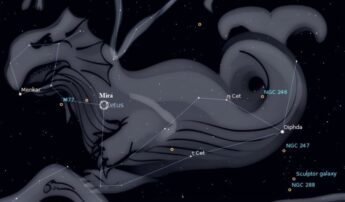This Week’s Sky at a Glance, 2023 Oct. 21 – Oct. 28
This Week’s Sky at a Glance, 2023 Oct. 21 – Oct. 28
Mid-autumn is a time for late-evening whale watching while the large constellation of Cetus the Whale is approaching the southern sky. Many of its stars are not particularly bright so it can be elusive, but you can piece it together in a fairly dark sky. The eastern side of the square of Pegasus is a handy arrow that points down toward Diphda, the brightest star in Cetus. Also called Deneb Kaitos, “the tail of the whale,” it anchors a pentagram of stars forming the rear half of Cetus below dim Pisces. A circlet of stars to the upper left, west of Taurus, is the whale’s head.
A famous star in Cetus is Mira, perhaps the first star to be recognized as a variable or one that changes its brightness regularly. The name Mira translates as “wonderful.” It is a red giant star that expands and contracts, while brightening as it expands. At minimum brightness it cannot be seen with binoculars but every 11 months it brightens to easy naked eye visibility. Midway on the western side of the circlet of the whale’s head is a star which anchors an asterism that resembles a question mark. Don’t ask why, just try it with binoculars. A scope or binoculars could reveal the galaxy M77 approximately midway between Mira and Menkar, the star at the bottom of the circlet.
In mythology Cetus represents the sea monster created by Poseidon to ravage the coastal area of Ethiopia as punishment for Queen Cassiopeia’s bragging. Her daughter Andromeda was chained to a rock at the seashore as a sacrifice to make the monster go away. Perseus was homeward bound on the back of Pegasus after slaying the Gorgon Medusa when he chanced upon Andromeda’s plight. He rescued the princess by using Medusa’s head to turn the monster to stone, winning the day and the hand of a princess.
This Week in the Solar System
Saturday’s sunrise in Moncton is at 7:44 and sunset will occur at 6:22, giving 10 hours, 38 minutes of daylight (7:47 and 6:29 in Saint John). Next Saturday the Sun will rise at 7:53 and set at 6:11, giving 10 hours, 18 minutes of daylight (7:57 and 6:17 in Saint John).
The Moon is at first quarter around midnight on Saturday evening, which is International Observe the Moon Night. The Moon approaches Saturn on Monday, passes near Uranus on Wednesday, and next Saturday the full Hunter’s Moon approaches Jupiter. By midweek Saturn is at its best for observing around 9 pm, and telescope users might see Jupiter’s Red Spot around 11 pm Tuesday and 8:30 pm Friday. Rising before 4 am, Venus reaches greatest elongation from the Sun on Monday.
The Sunday Night Astronomy Show from Saint John and Hampton airs at 8 pm Sunday on the Facebook page and YouTube channel of Astronomy by the Bay.

